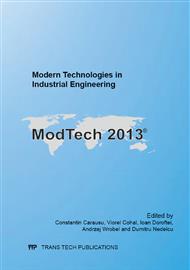p.369
p.375
p.381
p.387
p.393
p.399
p.405
p.411
p.416
Virtual Analysis of the Mining Support under Loads of the Roof
Abstract:
The paper presents the results of virtual analysis of the stability of mining roof supports loaded by the roof rocks. The hydraulic roof support generally accounts for over 50% of the total value of a coal mining and excavating system. Many reports show that in some conditions roof supports behave differently than foreseen. To explain this phenomena the investigations basing on the virtual model were done [1,2]. This phenomena is very dangerous for miners because this behaviour of a mining roof support may cause dangerous accidents in coal mines. In the investigation process some questions have been asked. Firstly what type of a mining support is more liable to this behaviour. Secondly what work conditions are the most dangerous. To analyse this phenomena it was used models of two types of a mining support. One with two props and one with four ones. Results show that that the problem of plunged of roof parts of a support in the coal bed is consider with the construction of the support. The most dangerous is the roof support with two props. The consequences of this results are the recommendations to use rather supports with four props then two.
Info:
Periodical:
Pages:
393-398
Citation:
Online since:
November 2013
Authors:
Keywords:
Price:
Сopyright:
© 2014 Trans Tech Publications Ltd. All Rights Reserved
Share:
Citation:


